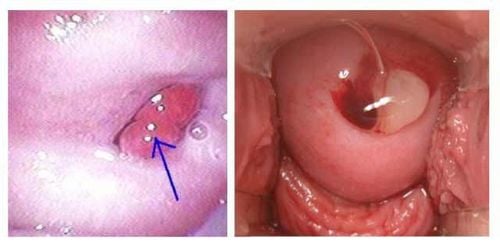This is an automatically translated article.
The article was written by doctors from Internal Oncology Department, Vinmec Times City International General Hospital.Under normal circumstances, a woman's uterus will secrete a limited amount of blood during each menstrual period (less than 5 tablespoons or 80 mL). Bleeding that occurs erratically or outside of the menstrual cycle is considered abnormal uterine bleeding. Once a woman has not taken hormone replacement therapy when she enters menopause and her menstrual cycle has ended, any uterine bleeding is
1. Causes of Abnormal Uterine Bleeding
Abnormal uterine bleeding can occur at any age.
Abnormal uterine bleeding in young girls - Bleeding before menstruation (first period in a girl's life) can be caused by trauma, foreign objects (such as toys, coins) or toilet tissue), irritation of the genital area (from bubble baths, soaps, lotions, or infections) or urinary tract problems. Bleeding can also occur from sexual abuse.
Teenagers - Many girls have irregular bleeding episodes for the first few months after their first period. This usually clears up on its own without treatment when a girl's hormonal and ovulation cycles return to normal. If abnormal bleeding persists beyond this time, or is accompanied by severe leg bleeding, further evaluation is warranted.
Irregular bleeding in girls can also be caused by any of the same causes as in menstruating women, including: pregnancy, infections and bleeding disorders or other medical conditions.
Women of childbearing age - irregular bleeding can be caused by sudden changes in hormone levels at the time of ovulation and cause small amounts of bleeding. Or it happens in oral contraceptive users who don't ovulate regularly.
Some women have regular menstrual cycles but experience excessive bleeding during their periods or bleeding between periods. The most common causes of such bleeding are fibroids or endometrial polyps. These are all benign lesions
Other causes of abnormal uterine bleeding in menstruating women include:
Pregnancy

Phụ nữ đang trong tuổi sinh đẻ - ra máu bất thường có thể do sự thay đổi đột ngột nồng độ hormone tại thời điểm rụng trứng và gây ra chảy máu một lượng nhỏ
Cancer or pre-cancer of the cervix or endometrium (the lining of the uterus) Infection or inflammation of the cervix or endometrium Coagulation disorders such as use of anticoagulants, urinary abnormalities requirements or problems with clotting factors Medical conditions such as hypothyroidism, liver disease, or chronic kidney disease Taking birth control pills - Girls and women using hormonal contraceptives (eg. e.g. pills, rings, patches) may bleed "suddenly" between cycles. If this happens in the first few months, it could be due to changes in the lining of the uterus. If it persists for more than a few months, a switch to another oral contraceptive may need to be evaluated. Irregular bleeding is common in women using the contraceptive implant. Cervical infections (including chlamydia or trichomoniasis) can cause abnormal bleeding, especially after sex.
Sudden bleeding can also occur if a birth control method is forgotten or taken late. In this situation, there is a risk that the woman could get pregnant if she has sex. An alternative or "backup" form of birth control (eg, condoms) should be used if the pill/patch/shot is not on time.
Women in the menopausal transition - Before menstruation ends, a woman goes through a period called menopause or perimenopause. During menopause, the timing of cycles begins to change as ovulation becomes less frequent. While the ovaries in perimenopausal women decrease in production of estrogen and progesterone. These hormonal changes can cause the endometrium to grow and create excess tissue, increasing the chances of polyps or endometrial hyperplasia (thick endometrial lining that can progress to cancer). ) will grow and potentially cause abnormal bleeding. The menopausal transition is a time when women are more likely to experience abnormal uterine bleeding.
Women in the menopausal transition are also at increased risk for other conditions that cause abnormal bleeding, including cancer, infections, and systemic diseases. Further evaluation is needed in women with prolonged irregular menstrual cycles or an episode of massive bleeding.
Women in the menopausal transition still ovulate for some time and can become pregnant; Pregnancy can cause abnormal bleeding. Additionally, women in perimenopause may use hormonal birth control pills, which can cause breakthrough bleeding.
Menopausal women - Causes of abnormal bleeding during menopause include:
Atrophy or excessive thinning of tissue lining the vagina and uterus, due to low hormone levels Cancer or precancerous changes ( hyperplasia) of the lining of the uterus (endometrium) Polyps or fibroids Uterine infection
Use of blood thinners or anticoagulants Side effects of radiation therapy
2. Evaluation tests
In addition to the clinical examination, asking about medical history, current medications, family history... Some tests need to be done such as pregnancy test. If there is any abnormal vaginal discharge, a cervical test may be done. Blood tests may also be done to determine if there is anemia (low blood count) or problems with blood clotting or other conditions throughout the body, such as thyroid disease, liver disease, or other kidney problems. kidney.
Tests to determine ovulation - Since hormonal abnormalities can contribute to abnormal uterine bleeding, testing may be recommended to determine if a woman is ovulating ( egg production) in each monthly cycle or not.
Endometrial evaluation - Tests that evaluate the endometrium (the lining of the uterus) may be done to rule out endometrial cancer and structural abnormalities such as fibroids or fibroids. uterine polyps. These tests include:
Endometrial biopsy - Endometrial biopsy is usually done in women 45 years of age and older to rule out endometrial cancer or abnormal endometrial growths often. A biopsy may also be done in women younger than 45 years if they have risk factors for endometrial cancer or feel at risk for endometrial infection. Increased risks for endometrial cancer include obesity, a history of breast cancer, tamoxifen use, or a family history of breast or colon cancer.
During a biopsy, the doctor inserts a thin instrument through the vagina and cervix into the uterus to take a small sample of endometrial tissue. Biopsy (usually causes death spasms) but does not require anesthesia. Because only a small portion of the endometrium is removed, a biopsy may miss some causes of bleeding, and other tests are sometimes needed.
Transvaginal ultrasound : an ultrasound probe is inserted into the vagina so that it is closer to the uterus and can provide a clear picture of the uterus. Endometrial lining is assessed and measured; postmenopausal women often have a thin endometrial lining; If the lining is thicker than 4 or 5 mm, an endometrial biopsy is needed. Ultrasound cannot distinguish between different types of abnormalities (eg, polyps versus cancer) and may require further testing
Hysteroscopy with biopsy
3. Treatment of abnormal uterine bleeding
Treatment of abnormal bleeding is based on the underlying cause.Birth control pills - Birth control pills are often used to treat uterine bleeding when it's caused by hormonal changes or hormonal abnormalities. Birth control pills can be used in women who don't ovulate regularly to establish their menstrual cycle and prevent overgrowth of the endometrium. In ovulating women, they may be used to treat excessive menstrual bleeding.

Thuốc tránh thai thường được sử dụng để điều trị chảy máu tử cung khi nguyên nhân do thay đổi nội tiết tố hoặc bất thường nội tiết tố
Progesterone - Progesterone is a hormone made by the ovaries that is effective in preventing or treating excessive bleeding in women who do not ovulate regularly. Intrauterine device - A progestin-releasing IUD (eg, Mirena, Liletta, Kyleena, or Skyla) may be recommended for women with abnormal uterine bleeding. The IUD is a T-shaped device that is inserted into the uterus. Surgery - Surgery may be needed to remove abnormal uterine structures (eg, fibroids, polyps). Women who have had a baby and have heavy menstrual bleeding may consider a hysterectomy. Women with fibroids may be surgically treated for fibroids by removing the fibroids (eg, fibroids) or by reducing the blood supply to the fibroids (eg, by embolization). uterine artery). The best surgical treatment for abnormal uterine bleeding is a hysterectomy, or removal of the entire uterus. At the time of hysterectomy, the ovaries may be left in place or removed. A hysterectomy can be performed using conventional laparoscopy or robotic laparoscopy.
Please dial HOTLINE for more information or register for an appointment HERE. Download MyVinmec app to make appointments faster and to manage your bookings easily.













